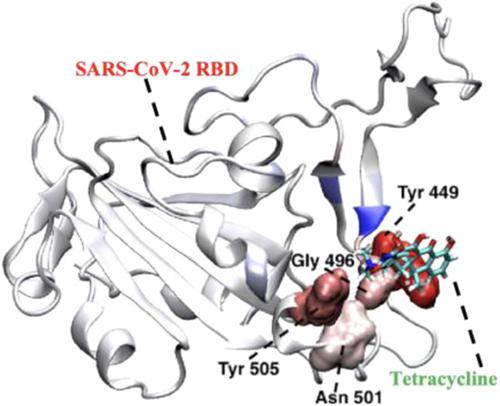当前位置:
X-MOL 学术
›
J. Cell. Biochem.
›
论文详情
Our official English website, www.x-mol.net, welcomes your
feedback! (Note: you will need to create a separate account there.)
Tetracycline as an inhibitor to the SARS‐CoV‐2
Journal of Cellular Biochemistry ( IF 3.0 ) Pub Date : 2021-02-22 , DOI: 10.1002/jcb.29909 Tom Y Zhao 1 , Neelesh A Patankar 1
Journal of Cellular Biochemistry ( IF 3.0 ) Pub Date : 2021-02-22 , DOI: 10.1002/jcb.29909 Tom Y Zhao 1 , Neelesh A Patankar 1
Affiliation

|
The coronavirus severe acute respiratory syndrome coronavirus 2 (SARS‐CoV‐2) remains an extant threat against public health on a global scale. Cell infection begins when the spike protein of SARS‐CoV‐2 binds with the human cell receptor, angiotensin‐converting enzyme 2 (ACE2). Here, we address the role of tetracycline as an inhibitor for the receptor‐binding domain (RBD) of the spike protein. Targeted molecular investigation show that tetracycline binds more favorably to the RBD (−9.40 kcal/mol) compared to doxycycline (−8.08 kcal/mol), chloroquine (−6.31 kcal/mol), or gentamicin (−4.83 kcal/mol) while inhibiting attachment to ACE2 to a greater degree (binding efficiency of 2.98 kcal/(mol nm2) for tetracycline–RBD, 5.16 kcal/(mol nm2) for doxycycline–RBD, 5.59 kcal/(mol nm2) for chloroquine–RBD, and 7.02 kcal/(mol nm2) for gentamicin–RBD. Stronger inhibition by tetracycline is verified with nonequilibrium PMF calculations, for which the tetracycline–RBD complex exhibits the lowest free energy profile along the dissociation pathway from ACE2. Tetracycline binds to tyrosine and glycine residues on the viral contact interface that are known to modulate molecular recognition and bonding affinity. These RBD residues also engage in significant hydrogen bonding with the human receptor ACE2. The ability to preclude cell infection complements the anti‐inflammatory and cytokine suppressing capability of tetracycline; this may reduce the duration of ICU stays and mechanical ventilation induced by the coronavirus SARS‐CoV‐2.
中文翻译:

四环素作为 SARS-CoV-2 的抑制剂
冠状病毒严重急性呼吸综合征冠状病毒 2 (SARS-CoV-2) 在全球范围内仍然对公共卫生构成威胁。当 SARS-CoV-2 的刺突蛋白与人类细胞受体血管紧张素转换酶 2 (ACE2) 结合时,细胞感染就开始了。在这里,我们讨论了四环素作为刺突蛋白受体结合域 (RBD) 抑制剂的作用。靶向分子研究表明,与多西环素(-8.08 kcal/mol)、氯喹(-6.31 kcal/mol)或庆大霉素(-4.83 kcal/mol)相比,四环素更容易与RBD(-9.40 kcal/mol)结合,同时抑制与 ACE2 的结合程度更高(四环素-RBD 的结合效率为 2.98 kcal/(mol nm 2 ),强力霉素-RBD 的结合效率为5.16 kcal/(mol nm 2 ),5.59 kcal/( mol nm 2)2 ) 氯喹-RBD,庆大霉素-RBD 7.02 kcal/(mol nm 2 )。通过非平衡 PMF 计算验证了四环素更强的抑制作用,其中四环素-RBD 复合物沿从 ACE2 的解离途径显示出最低的自由能分布。四环素与已知可调节分子识别和结合亲和力的病毒接触界面上的酪氨酸和甘氨酸残基结合。这些 RBD 残基还与人类受体 ACE2 形成显着的氢键结合。排除细胞感染的能力补充了四环素的抗炎和细胞因子抑制能力;这可能会减少冠状病毒 SARS-CoV-2 引起的 ICU 停留时间和机械通气时间。
更新日期:2021-02-22
中文翻译:

四环素作为 SARS-CoV-2 的抑制剂
冠状病毒严重急性呼吸综合征冠状病毒 2 (SARS-CoV-2) 在全球范围内仍然对公共卫生构成威胁。当 SARS-CoV-2 的刺突蛋白与人类细胞受体血管紧张素转换酶 2 (ACE2) 结合时,细胞感染就开始了。在这里,我们讨论了四环素作为刺突蛋白受体结合域 (RBD) 抑制剂的作用。靶向分子研究表明,与多西环素(-8.08 kcal/mol)、氯喹(-6.31 kcal/mol)或庆大霉素(-4.83 kcal/mol)相比,四环素更容易与RBD(-9.40 kcal/mol)结合,同时抑制与 ACE2 的结合程度更高(四环素-RBD 的结合效率为 2.98 kcal/(mol nm 2 ),强力霉素-RBD 的结合效率为5.16 kcal/(mol nm 2 ),5.59 kcal/( mol nm 2)2 ) 氯喹-RBD,庆大霉素-RBD 7.02 kcal/(mol nm 2 )。通过非平衡 PMF 计算验证了四环素更强的抑制作用,其中四环素-RBD 复合物沿从 ACE2 的解离途径显示出最低的自由能分布。四环素与已知可调节分子识别和结合亲和力的病毒接触界面上的酪氨酸和甘氨酸残基结合。这些 RBD 残基还与人类受体 ACE2 形成显着的氢键结合。排除细胞感染的能力补充了四环素的抗炎和细胞因子抑制能力;这可能会减少冠状病毒 SARS-CoV-2 引起的 ICU 停留时间和机械通气时间。











































 京公网安备 11010802027423号
京公网安备 11010802027423号